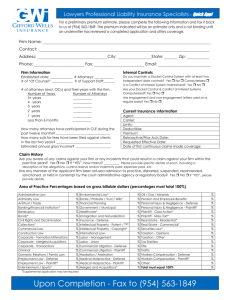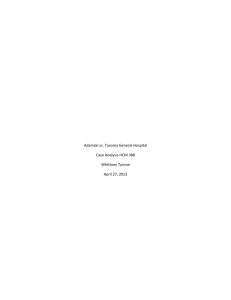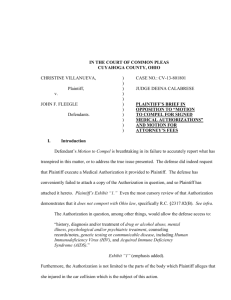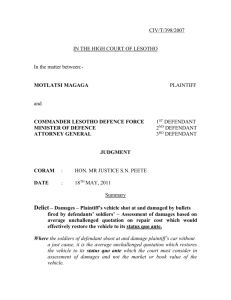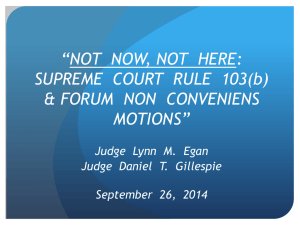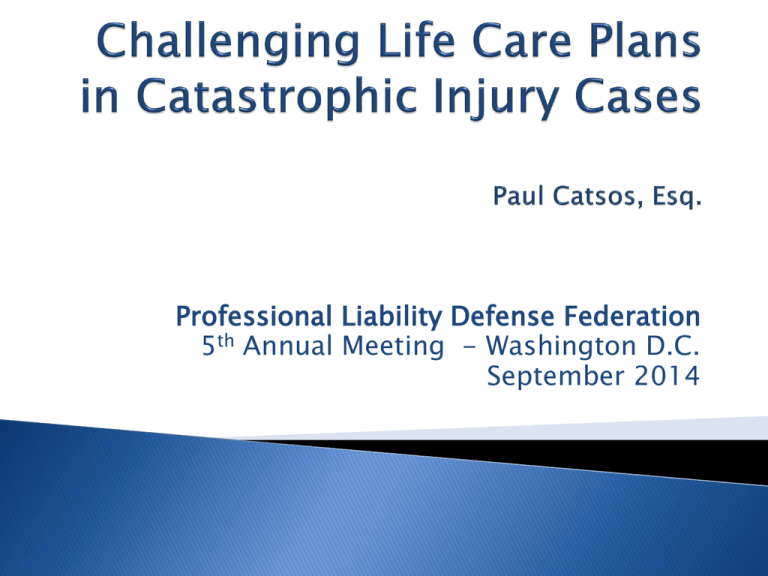
Professional Liability Defense Federation
5th Annual Meeting - Washington D.C.
September 2014
A tool which can be used to
estimate future medical and
related costs for catastrophic
and chronic injuries.
Plan changes as the
individual and his/her
treatment changes.
If conditions, situation
change, impacts future
needs.
Whether plaintiffs
condition improves or
worsens.
Is past treatment necessarily predictive of
future needs?
◦ Any studies to support that claim?
◦ Anecdotal evidence to the contrary - experience
with Medicare Set Aside agreements.
Will the science/treatment change?
How about costs, interest, life expectancy?
Do life care planners have crystal ball to know
how?
The BiOM Ankle System from iWalk
The Power Knee from Ossur
The Proprio Foot from Ossur
The Symbionic Leg from Ossur combines the Proprio powered
ankle and the Rheo microprocessor knee
The iLimb from Touch Bionics.
The Bebionic from Steeper is an advanced myoelectric
prosthetic hand
The Boston Digital Arm System from Liberating Technologies
supplies the necessary torque for a variety of tasks, with onboard software for control.
Intrepid Pup shows off prosthetic paws
American Association of Nurse Life Care
Planners - AANLCP® recognizes the Nurse
Life Care Planner as the Registered Nurse
(R.N.) who assesses, identifies problems,
plans for appropriate interventions,
implements and evaluates the plan in the
Nurse Life Care Planning process. AANLCP®
promotes the professional practice that the
Registered Nurse delivers to the life care
planning process
“Experts?”
Not retained to treat plaintiff.
Training:
◦
◦
◦
◦
In Nursing
Psych training
Rehabilitation training
Chronic pain training
Have they ever cared for this type of patient?
- brain injury, burns, spine, amputation,
birth injury, other?
Have they made a life care plan for this type
of patient?
Is it beyond scope of license to make a
determination as to diagnosis?
Nursing vs. medical diagnosis
Can the life care planner prescribe?
Establish that their report is only as good as
the information provided by other experts on
which they rely.
What information from plaintiff’s counsel?
What information from plaintiff’s PCP?
What information from plaintiff’s surgeons?
What Information from plaintiff?
Other sources of information as to future care
needs?
But, what does the patient say?
◦ Which medical records were relied on?
◦ Pharmacy records obtained from all
pharmacies and providers?
◦ What info on durable medical goods
(DMG) used?
◦ How current is the plan?
Where acquire costs information for
treatment?
How determine to be usual and customary?
Consider other suppliers, facilities,
pharmacies, or sources for averages in
calculating cost of plan?
Are there fee schedules, billing agreements,
etc which suggest future costs are lower?
Is treatment necessary?
Challenge with opinions defense experts
◦ Physicians
◦ Psych experts
◦ Pharmacist
◦ Economist
◦ Annuity specialist
◦ Life Care Planner
◦Focus on whether treatment
is necessary
◦If so, for how long?
◦Alternatives to specific
treatment
◦Alternatives to entire plan
Analyze
reasonableness of
current drug use
Analyze reasonableness of
future drug use
Alternatives
Costs
Reasonable and Necessary?
Does plaintiff use all drugs which are
prescribed now?
◦ Is he/she compliant and current?
Are there cheaper alternatives now?
Will there be cheaper alternatives in the
future?
Generics?
Where injury suffered by the plaintiff is permanent,
damages based on the probable duration of the
plaintiff’s life must be supported by evidence of what
that lifespan might be.
The majority of courts use mortality tables that apply
actuarial statistics to “suggest an average life
expectancy for a person of a given age and sex.”
The majority view is that mortality tables are not
conclusive evidence on the issue of life expectancy or
binding upon the jury. Instead, the tables “may be
considered in connection with other evidence bearing
on the probable life expectancy of the plaintiff, such
as health, habits, occupation, and other activities.”
Sometimes referred to
mortality tables, death
charts or actuarial life
tables, this information is
strictly statistical.
It does not take into
consideration any
personal health
information or lifestyle
information.
This information has been
provided by the US
Census and Social
Security Administration.
“The current dollar value of a future amount”
or the sum of money “that would have to be
invested today earning a given interest rate
over a specified period to equal the future
amount.”
◦ Trained to calculate present value?
◦ Where is present value in plan?
◦ How was it calculated?
◦Present Value
◦Life expectancy
Qualified to discuss comorbidities?
◦ Hire to assist with critique of
plan
◦ Review methodology of
plaintiff’s planner
◦ Create a defense plan to be
introduced to fact finder?
Have a Great Evening!
Paul Catsos is a partner at Thompson &
Bowie, LLP, a defense firm which is a member of
Themis Advocates. His practice focuses on civil
litigation, including professional liability, products
liability, food and medical devise claims in both
Maine and New Hampshire. He is also Maine's
President to the Tri-State Defense Lawyers’
Association and an Adjunct Assistant Professor at
the University of New England's College of
Pharmacy. He graduated from Cornell University in
1982 and Suffolk University Law School, where he
graduated cum laude in 1989.


